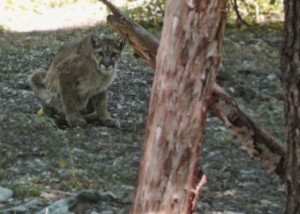As we were finishing up the post on mountain lions last week, the story broke that Dan Richards, President of the California Fish and Game Commission, had killed a mountain lion in Idaho on an arranged hunt. After a long chase led by hunting dogs, he shot the exhausted animal out of a tree where it had climbed to escape the dogs. Later that night Richards dined on his kill and gloated about it in a letter to a California state lawmaker. Not so surprisingly, public outrage has erupted and there have been calls for his resignation since the Commission is involved with protecting California’s wildlife. But Richards’ defenders point out that hunting mountain lions is legal in Idaho.
The question arises: where do we Californians want to see our mountain lions? Clearly, the majority has said, “Not on our dinner plates or stuffed and mounted on a wall.”
We have voted repeatedly to give full protection to mountain lions. We are the only state to do so. Reasons for this impassioned support range from our emotional attachment to a beautiful, wild, and charismatic animal to a deeper understanding of what critical role this top predator plays in keeping a variety of ecosystems healthy. Mountain lions are a flagship species. (See http://www.saveknowland.org/2012/02/28/mountain-lions-in-the-east-bay-hills-why-conservationists-should-care-about-knowland-park/#more-2259)
But those of us living in urban areas such as the East Bay Hills are now faced with harder choices and a very steep learning curve. Only recently have we confirmed that mountain lions are already here living among us. And even more recently have the experts told us that though the mountain lions are here now, if they are to persist and thrive, they need every bit of habitat that we can provide and then some. Refraining from shooting and eating them is not sufficient for them to survive.
To provide for them means that we have to say no to development in high quality habitat. There simply isn’t enough of it left. For institutions which aspire to lead the public in conservation, the fact of mountain lions in our midst ought to be cause for celebration and a corresponding accommodation to protect their habitat. Yet the zoo, hellbent on its current plans, continues to treat the extraordinarily rich habitat of Knowland Park as an inconvenient truth.
It need not be. There is plenty of room for a zoo expansion as was originally envisioned in the 1996 Zoo Master Plan. The Oakland Zoo is one of the most fortunate among urban zoos because it is surrounded by degraded land suitable for development and animal exhibits. It also has proximate wild lands that host a rich array of animals and plant species. If the Oakland Zoo is to achieve true greatness, it will be because it marries the idea of conservation with the practice of it in its own backyard. It can display its captive and bred mountain lions (and other top predators) while simultaneously encouraging the public to protect the local resident mountain lions and other wildlife in Knowland Park now–serving as a role model by resisting the temptation to build in their habitat.
The opportunity is here to heed the mountain lion ambassadors from the wild who have arrived to show us that we can live together right here, right now– if only we have the will and conscience to adapt
 Laura Baker is an environmental activist and former conservation chair of the East Bay Chapter of the California Native Plant Society. She holds an MA in ecology and systematic biology. Growing up in Missouri, she learned early that the cure for most ills rests in spending time out in nature. She wishes for every child to have the experience of wholeness that nature provides.
Laura Baker is an environmental activist and former conservation chair of the East Bay Chapter of the California Native Plant Society. She holds an MA in ecology and systematic biology. Growing up in Missouri, she learned early that the cure for most ills rests in spending time out in nature. She wishes for every child to have the experience of wholeness that nature provides.
Laura’s Knowlander blog is dedicated to building an online library of the natural history of Knowland Park so that the public may enjoy the park for the natural heritage treasure that it is. Knowing the land is a never ending process of inquiry open to all. We welcome your comments, contributions, and photos.

 Follow
Follow







